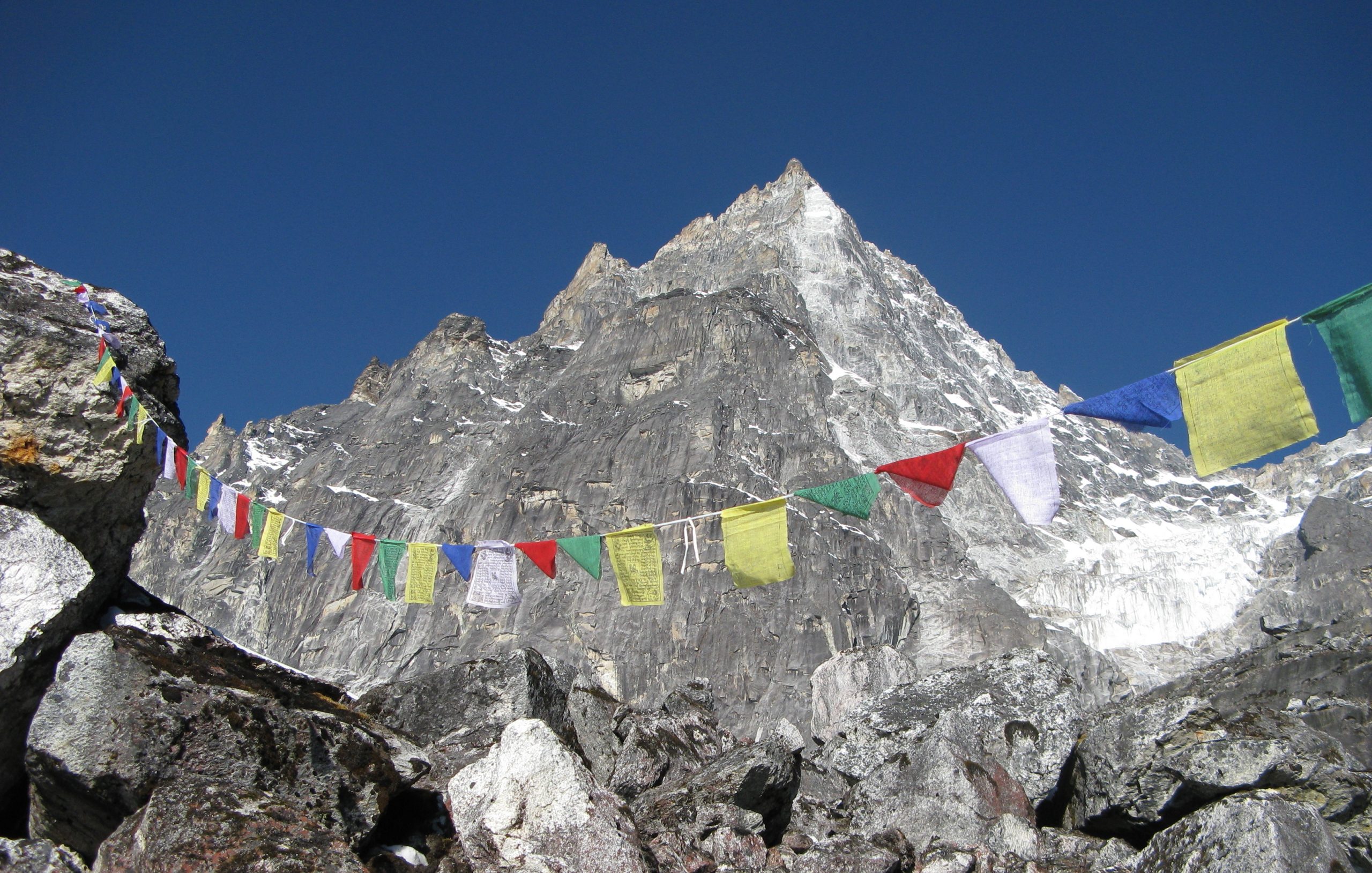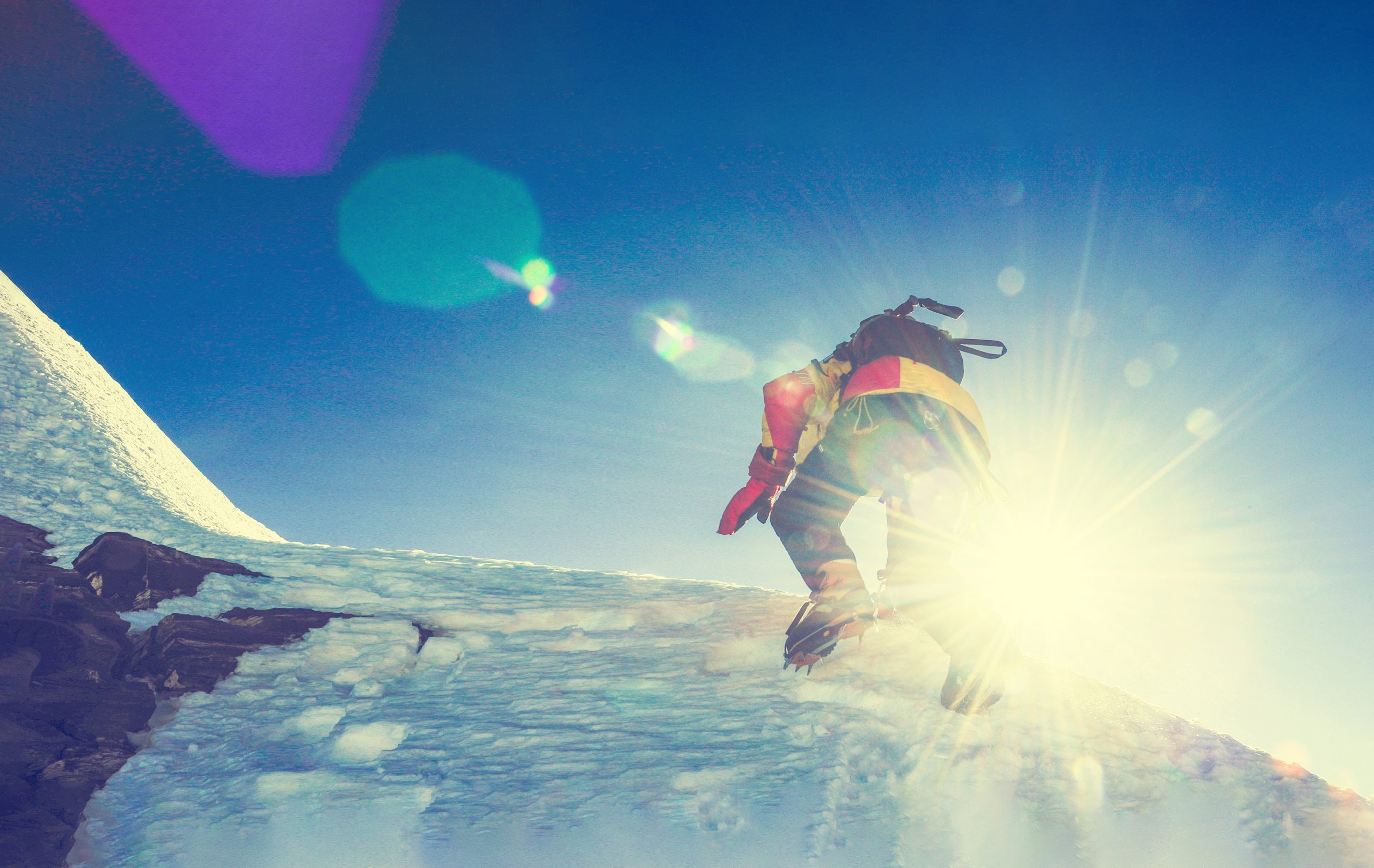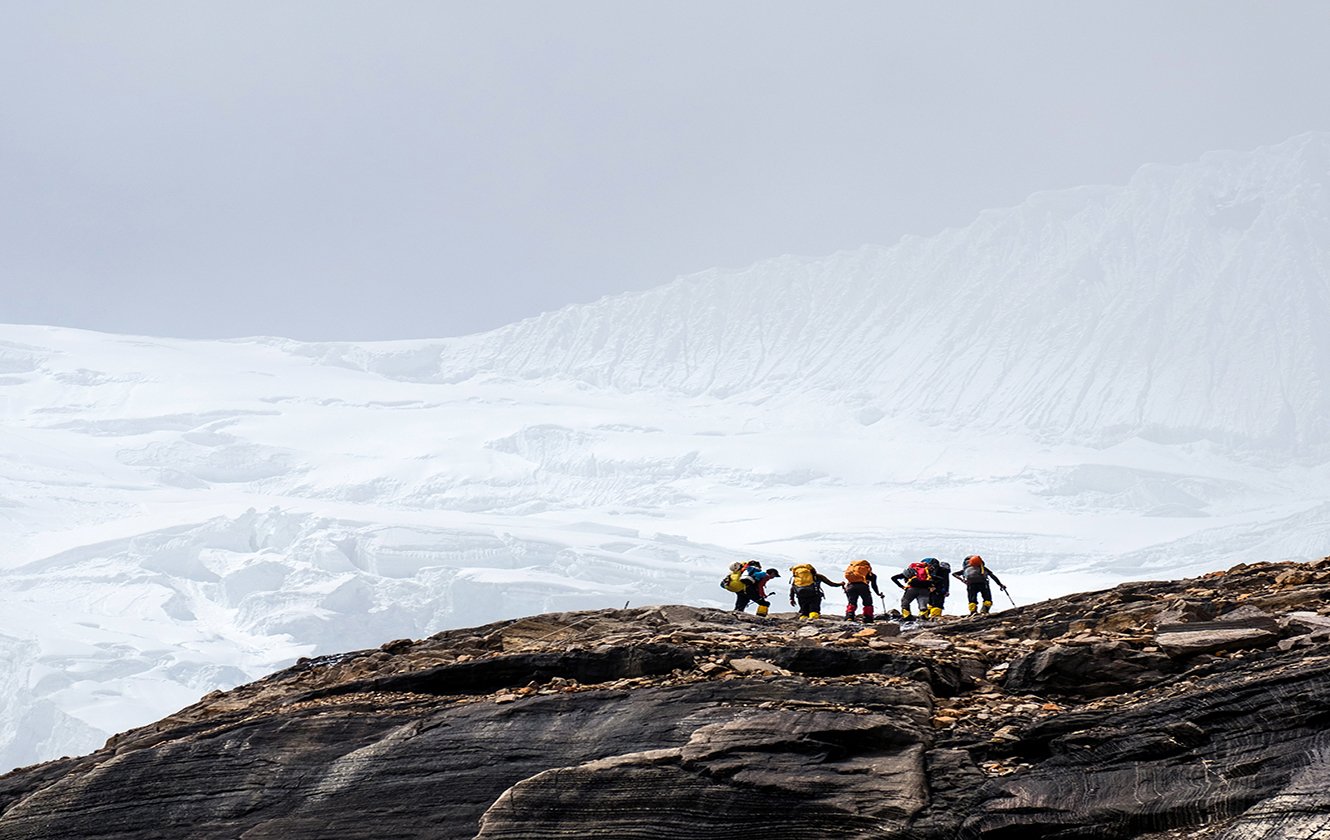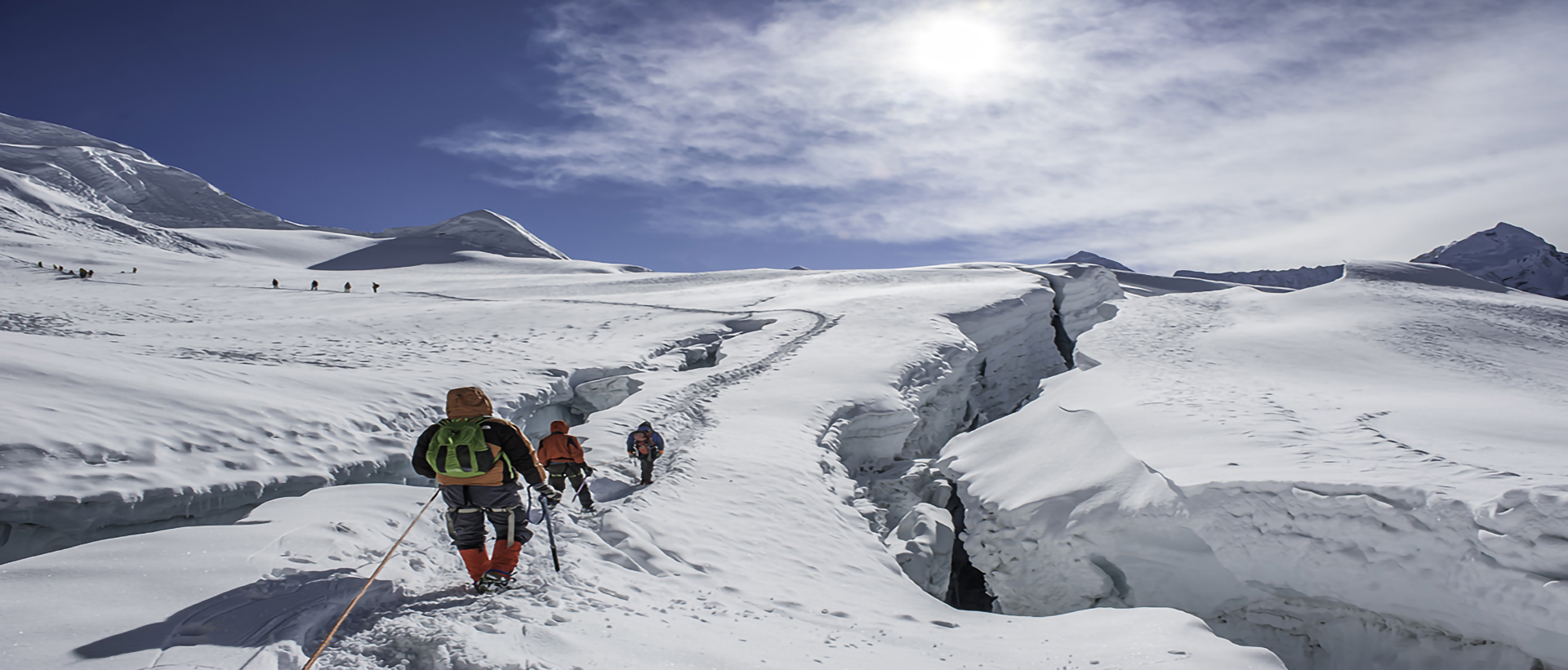
ISLAND PEAK – MT. IMJA TSE
Elevation: 6189 Meters
- Home /
- Nepal /
- Peak Climbing & Expeditions /
- ISLAND PEAK – MT. IMJA TSE
The trek and the climb of Imja Tse take one to the foothills of the mightiest of the mountains in the world. En-route, traverse through rhododendron and pine forests, rivers, Sherpa villages and Buddhist Monasteries from temperate to snow line regions. The Himalayas are best seen on this trek as one trace the main route through the Khumbu region from the Sherpa town of Namche Bazaar. Trekkers get a close view of the world’s greatest mountains, Everest, Lhotse, Nuptse, Thamserku, Tawache and others. This is a moderately tough trek. To climb the Island Peak requires skill in rock climbing
Eric Shipton’s Party who were on their way to explore the Barun Gorge gave the name of Island Peak to this Mountain in 1952. Seen from Dingboche the mountain does indeed resemble an Island in a sea of ice. In 1983 it was renamed Imja Tse, although for most people the descriptive name of Island Peak seems to have been retained.
The mountain was first climbed in 1953 by a very prestigious team in preparation for the ascent of Everest. They were Charles Evans, Alf Gregory, Charles Wylie and Tenzing Norgay, with seven Sherpas who were trying out the newfangled oxygen sets; as practice, of course, for loftier things. Fortunately this didn’t set a precedent and most people seem able to climb it without bottled air, although a Sherpa once reached the summit with called the cigarette he was smoking, ‘Sherpa Oxygen’.
Itinerary In Detail
-
Day 01: Arrival in Kathmandu.
Arrive at Katmandu Tribhuvan International Airport and meet, assist and transfer to the hotel by a representative from Asiatic Roads.
At the hotel a short briefing about the trek and then check into the room.
Eve: Welcome Drinks and Dinner at an authentic Nepali restaurant.
Overnight at hotel.
-
Day 02: Gear check and Orientation in Kathmandu.
The day is free in Kathmandu for rest, last-minute shopping, gear check, and Trek / Climb Orientation in Kathmandu.
Dinner and overnight at hotel.
-
Day 03: Fly to Lukla & Trek to Phakding (2652m) - 3 Hours.
Early morning transfer to the airport to fly to Lukla (2880m). This 45-minute flight provides a magnificent entry to the trek. It highlights the snowline of the Himalayan Range in the north and the rugged landing at the Lukla airport, which is said to be one of the most spectacular flights in the world. Upon arrival, meet the Sherpa team and while the team reassembles the equipment for the distribution to the Porters and Jhopke (a cross between and cow and a Yak used to carry loads), there will be a short lunch break. During this break, the guests are welcome to explore this bustling town on top of a hill with rows of houses, hotels and shops lining both sides of cobbled street.
After lunch, the trek starts by following the trail leading to the northwest direction through the narrow street, which immediately descends from the end of the village on a trail through the open hillside. The trail is well defined and there are many shops and lodges catering to the trekkers. The trek this day is a very easy one and ultimately descends to the river at Phakding (2652m). Flight- 40 min. Trek- 3 hours.
Dinner and Overnight at Phakding.
-
Day 04: Trek to Namche Bazaar (3447 m) – 5 ½ Hrs.
Leave the main village, and the follow the trail on the left bank of the Dudh Kosi River. It is a pleasant walk for the first half of the day as one passes through agricultural countryside, small wayside villages and a monastery. Just before lunch, there is a steep climb of about 20 minutes to arrive at Monjo for Lunch.
After lunch, trek up to the checkpost to check the permits and enter into the Sagarmatha National Park. Descend for 10 minute and then cross a suspension bridge to arrive at Jorsale (2800m). Pass through several small villages and beautiful pine forest. This is a busy trail with plenty of human interest. Our first good views are of the west ridge of Kusum Kangru (6339m). Follow the Dudh Kosi River, crossing a rickety suspension bridge, which is in a dilapidated condition, and then slowly climb up a very steep trail to Namche Bazaar. Near half waypoint, we enjoy our first views of Mt. Everest (8848m), Nuptse (7879m) and Lhotse (8383m) – the big three. The climb is for nearly 3 hours as one gain in altitude making breathing difficult due to rarified air. Arrive at a gate with a sign saying, “Welcome to Namche Bazaar” but it is very misleading as it takes another 20 minutes to arrive at the main town. We camp in the heart of the Namche Bazaar (3447 m). This prosperous town is the largest in Khumbu. Mt. Thamserku (6648 m) and Kwangde Ri (6624 m) loom along the east and west of the village. The sacred mountain Khumbila (5707 m) dominates the skyline along the west.
Dinner and Overnight at Namche Bazaar.
-
Day 05: Acclimatization day at Namche
Today one can go around the town and see the busiest town in the Khumbu region. One can also go to see a small museum at the top of the hill in Namche.
Overnight at Namche.
-
Day 06: Trek to Thyangboche (3863 m).
We start the day by first going to the check post to check our permits and then walk uphill for about 10 minutes from where the path is more or less steady for the next 2 hours. On the way we get a dramatic view of Amadablam (6696 m) and Kangtaige (6779 m) flanked by the towering view of the Sagarmatha (Everest), Lhotse and
Nuptse. Descend through the rhododendron forest, watching for the blood pheasant and Imphayan pheasant in the undergrowth.
Descending down to Imja Khola (river) for a lunch stop at Phunki (3200m), next to several large water driven prayer wheels. The afternoon is spent climbing slowly on a steep trail to the Thyangboche Monastery and one of the most beautiful spots on earth. Thyangboche lies at the base of Kangtaiga and is a classic setting with superb views backs up the valley to the Ama Dablam, and the Everest poking its southwest face over the huge ridgeline linking Nuptse and Lhotse. At the rear is the beautiful west face of the Tamserku (6608m) and Kang Taiga (6685m).
The Thyangboche Monastery is one of the most important monasteries of the Khumbu Region and the late afternoon can be spent visiting this ancient Monastery. It is the traditional place where all Everest Expeditions receive their blessings as they walk in towards the base camp. The duration of the trek is – 5 ½ hours.
Dinner and Overnight at Thyangboche.
-
Day 07: Trek to Dingboche (4350 m. /14,880 ft.) - 5 hrs
After breakfast, set out on the trail with a short, steep and muddy descent through a forest of birch, conifer and rhododendron to the meadows of Devouche. Continue on a level trail trough forests to arrive at a suspension bridge high above the fast flowing Dudh Kosi River with fine views of Mt. Amadablam. Cross the suspension bridge and climb for another 10 minutes to arrive at a resting place. Continue to climb to a pass and then there is a gentler walk to the village of Thyangboche (3985m), which also has a monastery. The monastery lies more on the route to Phortse and is not easily reached from the lower trail and for those who desire to visit the monastery, the trail bifurcates just before the village after the pass and a hard half hour of climb up the ridge brings one to this fabled monastery. At the monastery is housed the Scalp of the Yeti which traveled the world in the 60’s.
After lunch, pass through this village and take the right hand trail through the front yard of a few herders’ huts, over a stonewall. The landscape becomes very interesting as the vista opens before us and we can see the river flowing far down below as we take the trail that has been cut out along the sheer cliffs of rocks. A further, 40 minutes of walking brings us to the upper Pangboche Village from where there is a very steep climb to the ridge before descending to Khumbu Khola. Cross the bridge on a wooden bridge and from the bridge it is a 20-minute walk, usually in fierce winds to the valley of Dingboche.
Dinner and Overnight at Dingboche.
-
Day 08: Dingboche – acclimatization day.
As per the study on high altitude sickness, it has been found that most of the people suffer or show signs of Acute Mountain Sickness (AMS) from the altitude of 14,000 ft. Thus it is highly recommended to have a rest day to acclimatize at this altitude before starting an ascent.
Dinner and overnight at Dingboche.
-
Day 09: Trek to Chhukung - 2 hrs
Walk past the Dingboche village and after that the trail becomes a gentle uphill as they say in Nepali “Nepali Flat”, till we reach Chhukung. Trek Duration 3 Hrs.
Dinner and Overnight at Chhukung.
-
Day 10: Trek to Paresaya Gyab (5000m / 16250ft) - Base Camp
Walk pass the small village of Chhukung. As we walk we notice the change in the trek route as we start to see more of rocks, stones and gravel’s on the way. The trek becomes tough not only because of the high altitude also because of the roughness of the route.
Trek duration 3 ½ hrs.
Overnight at the Base camp.
-
Day 11: Rest for acclimatization.
Overnight at Base Camp
-
Day 12: Attack Camp / High Camp (5600m / 14300ft) – 3 – 4 hrs.
From Base Camp the route skirts southeast around the base of Imja Tse between the moraine and the mountain before turning northeast and climbing steep grassy slopes and small rocky steps. Occasional Cairns is to be found marking the path. Easy scrambling up an open gully leads between two well-defined ridges and the site of high camp on the left-hand ridge below and to the right of a small hanging glacier (5,280 m/ 17,323 ft.). Care should be taken in the placing of a camp or bivouac to avoid possible avalanche danger from ice above.
From high camp on the left-hand ridge scramble across the board open gully and gain the right-hand ridge. Follow this, which gives easy scrambling to the snow-covered glacier above. A way needs to be found out leftwards, avoiding seracs and crevasses before turning back northwards over snow-covered scree in the margin between the glacier and the base of the main summit ridge.
After crossing a gully with some stone and icefall danger, a steep snow and ice ramp leads upwards for nearly 100 meters (300 feet), to the summit ridge. The last moves on to the leave a fixed rope in place to aid descent. The ridge itself is a classic and undulates towards the main summit, which is reached by a final tricky snow pitch. Grade: Alpine PD.
Dinner and Overnight at High Camp.
-
Day 13: Summit Island Peak (6189m) & back to Base Camp
First ascent was in 1958 by Alf Gregory, Dick Cook and two Sherpas. North of the main summit the ridge continues to a col (5700 m./ 18,700 ft.). The route climbs the ridge from the col, which is reached by following the true right bank of the Imje Glacier and later the moraines on the right bank of the Lhotse Shar Glacier, before climbing north-west over snowy slopes to the col. On the first ascent, a camp was placed on the col. From the col, follow the ridge which is a magnificent snow arete, due south. This steepens for the final summit pyramid. This is a long ridge that would be difficult under soft snow conditions and may under other conditions have a marked cornice. The climb is a little more difficult than the normal route, and is graded Alpine PD+.
Without doubt a complete traverse of both the routes described would make a superb outing, especially so with parties traversing from each and so that there was no need to backtrack to collect camps.
Dinner and Overnight at Base Camp or Chhukung.
-
Day 14: Back track to Pangboche (3985
After breakfast set out backtracking on scattered rocks and jumbled moraines to return to Dingboche. Cross Chukkung on the way and this walk is going to be much easier as we lose altitude, A climb over the ridge past Chortens and Main walls brings us into the Chukung village and the prosperous village of Dingboche. However we continue to trek to Pangboche, which is about 2 hours from Dingboche The route, starts back through the long walled paths of the Dingboche village, and a gradual ascent along the flanks of the hills below the village before a steep drop to the Dudh Koshi. A little further, the route joins the main trail coming from Pheriche.
The route then passes through the village of Pangboche (3985m) to set up camp.
Overnight at Pangboche.
-
Day 15: Trek back to Namche Bazaar
Having been consistently at high altitude above 4200m most trekkers welcome the thought of returning to warmer. After breakfast, the walk to Thyangboche is a delightful way of doing so and is about an hour from Pangboche. Continue to backtrack and then descend to the spectacular little bridge over the Dudh Kosi river and head through the fir and rhododendron forest for a lovely afternoon’s walk to the meadows of Devouche. From here, there is a short climb before reaching Thyangboche.
Descend to the Imja Khola and the small village of Phunki (3250m) with its water powered Prayer Wheels in about 45 minutes. The original bridge built by
Sir Edmund Hillary was washed away when a flood caused by the landside from the Ama Dablam caused a flooding in this region. Cross the river over the smaller bridge and start the climb towards Khumjung. As the gradient lessons there are many beautiful lunch spots. After lunch start the trek towards Namche by following the path around the eastern flanks of the hills.
Overnight at Namche Bazaar.
-
Day 16: Backtrack to Lukla
The trek from Namche to Lukla is a long days walk. From Namche, head to the end of the village and then immediately start to descend to the river. If going up was tough it is equally hard to get the footing and walk down hill. Head along the banks of the river and then further descend to Monjo for Lunch. It is interesting to watch others starting enthusiastically on the trek ahead.
From Phakding, it is a surprising hard uphill climb to Lukla, which should take about 3 hours. It is a delightful ending to the trip as one enters into this busy village and our campsite at Lukla.
Overnight at Lukla.
-
Day 17: Lukla / Kathmandu
Early morning, fly from Lukla to Katmandu on a twin Otter. Upon arrival, meet, assist and transfer to the Hotel.
The rest of the day is free.
Overnight at hotel.
-
Day 18: In Kathmandu / Contingency Day in case of delay.
This is a contingency day in case of delays to the Lukla flight. There is an optional complimentary guided sightseeing tour of the city’s main attractions.
Alternatively, you may prefer to do your own thing, especially if you have visited Kathmandu before.
The city tour includes a visit to the Hanuman Dhoka (Kathmandu Durbar Square) – an ancient durbar (palace) with its numerous old palaces, temples and pagodas, the Temple of Living Goddess “Kumari”, and the Kasthamandap Temple, which is believed to be constructed from the wood of a single tree from which Kathmandu derives its name. In addition, also visit the Boudhanath Stupa – an ancient colossal stupa and the center of Tibetan Buddhism in the world and the Pashupatinath Temple- the Temple of Lord Shiva situated on the bank of the holy Bagmati River.
Pm: After lunch drive up to the Swayambhunath Stupa situated atop a hill from where you could get a bird’s eye view of Kathmandu Valley. The Swayambhunath Stupa is also known as the “Monkey Temple”!!
Eve: Group farewell dinner at a nice restaurant in Thamel.
Overnight at hotel.
-
Day 19 : Free till final departure from Kathmandu.
Free till final departure assisted by the representative from Himalayan Holidays.
19 Days From
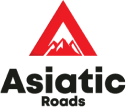
Any Question?
Feel free to call our travel experts.
+977 9851189018, +977 9801089018
info@asiaticroads.com
Whats Include and Exclude
Services Inclued
- All arrival, and departure transfers in a private tourist vehicle.
- Four nights stay at hotel in Kathmandu (4 Star) on BB basis.
- Teahouse trek arrangement from Lukla to BC and back to Lukla inclusive of accommodation at local teahouse lodges, meals (breakfast, lunch and dinner)
- Camping arrangement in High Camp inclusive of all High Altitude gears, food, and fuel.
- Services of the Support team (Licensed Climbing Guide, support Sherpa, and reliable porter/s) including their insurance and daily wages.
- Trekking permit with all necessary documentation fees.
- Island Peak climbing permits from Nepal Mountaineering Association.
- Climbing fees & equipment allowance for Mountaineering Guide
- Comprehensive medical kit and portable hyperbolic chamber.
- Daily and Equipment allowance for Climbing Sherpa.
Services not Inclued
- International airfares and airport departure taxes.
- Airfare for sector Kathmandu / Lukla / Kathmandu.
- Nepal visa fees.
- Any meals except breakfast at hotel in Kathmandu.
- Personal Climbing Gears, Sleeping bags, Down jacket, etc. (See List)
Items of personal nature such as bar bills, laundry, telephone calls, Internet, extra mileage, and personal gratuities as tips to guides
Other Costs (if Applicable)
| Particulars | Cost per person in US Dollars |
|---|---|
| 2/3 Pax | US$ 2,839.00 |
| 4/5 Pax | US$ 2,399.00 |
| 6/7 Pax | US$ 2,325.00 |
| Single supplement | US$ 250.00 |
Cost Note
The costs mentioned below are Net per person payable to us in US Dollars on a Twin Room Sharing basis, inclusive of all applicable government taxes, non-commissionable and valid till 31st Dec.
Airfare for sector Kathmandu / Lukla / Kathmandu is US$ 360.00 net per person.
Accomodations
19 Days From

Any Question?
Feel free to call our travel experts.
+977 9851189018, +977 9801089018
info@asiaticroads.com
19 Days From

Any Question?
Feel free to call our travel experts.
+977 9851189018, +977 9801089018
info@asiaticroads.com
Reviews
In my 2 week stay, John was very professional and took me around to experience all that Kathmandu and surrounding areas has to offer. Sites were seen and many locals were met through John’s network.

Steven Stone
TravellerIn my 2 week stay, John was very professional and took me around to experience all that Kathmandu and surrounding areas has to offer. Sites were seen and many locals were met through John’s network.

Steven Stone
Traveller19 Days From

